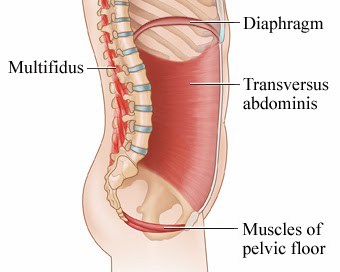The pelvic floor is the name given to the area that makes up the bottom of the pelvic outlet. It includes the pelvic floor muscles (levator ani) and the fascia that provides attachment to the pubic bone in the front, the lateral side walls, and coccyx at the back. The pelvic floor supports the internal pelvic organs and assists in normal bladder, bowel and sexual functioning. It plays a key role in core stability and works together with the deep abdominal stabilisers, lumbar stabilisers and the diaphragm. A pelvic floor that is not functioning optimally therefore affects many different systems that link together.
- Abdominal, pelvic or back surgery
- Scar tissue
- Chronic constipation and dysfunctional defecation
- Radiation
- Pregnancy and child birth
- Chronic constipation
- Heavy lifting
- Surgery
- Obesity
- Injuries and Falls
- Poor posture and chronic holding patterns
- Previous Trauma
- Bladder
Stress urinary incontinence, urinary urgency, urge incontinence, frequency, painful urethra and bladder (interstitial cystitis) or an inability to initiate flow. - Bowel
Haemorrhoids, rectal prolapse, Irritable Bowel Syndrome, abdominal pain and discomfort. Symptoms may include faecal incontinence, faecal urgency, defecation dysfunctions (constipation or inability to evacuate completely) and rectal pain. - Pelvic organ descent
Prolapse of the urethra, bladder, uterus or rectum or small intestine may occur through the vagina or through the back passage. You may also feel a sensation vaginal bulging and heaviness. - Pelvic pain
Includes painful intercourse (dysparaenia) in women.Pudendal neuralgia, coccydynia, anismus, sexual dysfunctions, low back, abdominal and pelvic pain patterns. - Sexual functioning
- Female
Vaginismus (pain or inability to penetrate), poor sensation, difficulty reaching orgasm.
- Female
Pelvic physiotherapy would involve a detailed history taking and examination. This may include examination of the abdomen, low back, posture, pelvis, pelvic floor and any other area that could be interlinking.
Treatment may include pelvic floor strengthening, relaxation, timing, breathing retraining, postural retraining, muscle and fascial mobilisation, visceral mobilisation, biofeedback and any other supportive treatment.
Even if you are able to activate the correct muscles, there is a lot more to normal functioning than just a kegel contraction. A good pelvic floor muscle needs to be able to squeeze well, relax completely and do this at the right time. Timing plays a critical role inadequate function. These fundamentals may need to be rehabilitated more specifically.
This is one of the biggest problems when trying to rehabilitate the pelvic floor. Very often every other muscle except the pelvic floor is kicking in and exercises become ineffective. It is very hard to know if you are doing the exercises correctly, especially when you have a poor awareness of what it feels like to contract your pelvic floor. One of our main roles is to make sure that the exercises you are doing are actually working the correct set of muscles and giving the desired result.
Various incorrect exercise regimes may worsen symptoms. Too much exercise and focus on a pelvic floor contraction but not on a complete relaxation, may result in the muscles becoming tight and sore. A tight pelvic floor may cause pain, constipation or aggravate certain bladder symptoms. If while trying to contract you are bearing down, symptoms such as prolapse may worsen.





